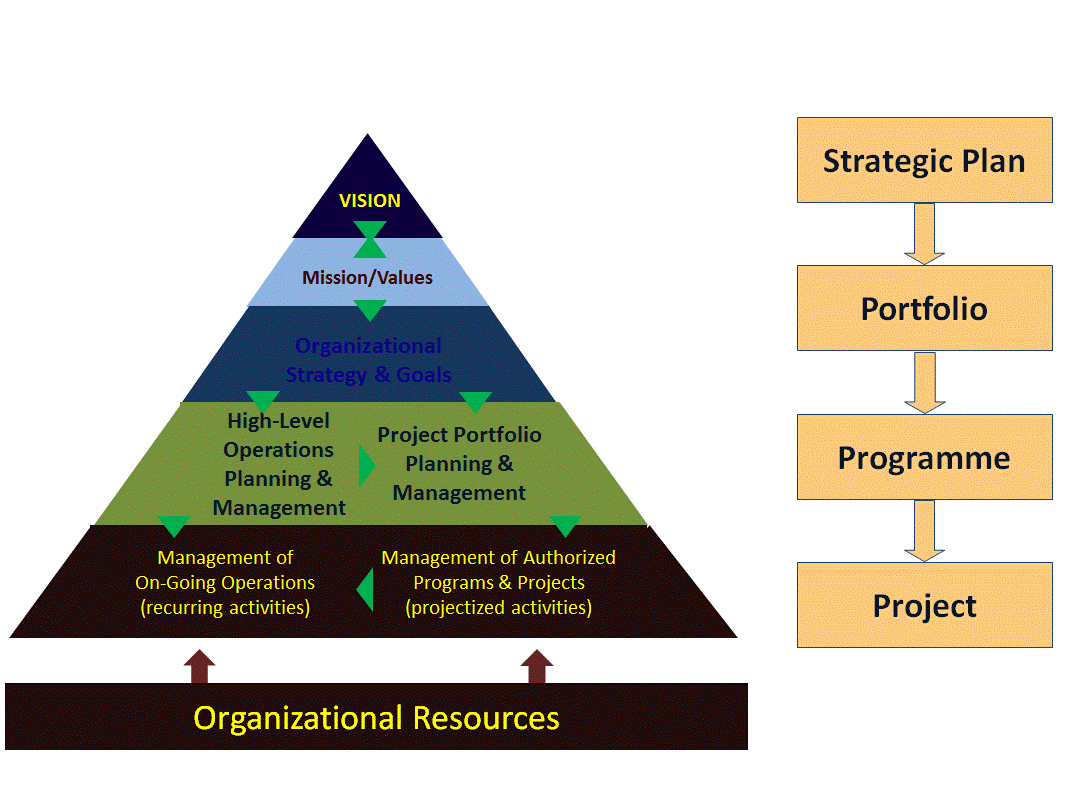Looking for Global training? Go to https://firebrand.training/en or stay on the current site (United Kingdom)
TERMS AND CONDITIONS
Firebrand Training grants you a personal, non-exclusive, non-transferable license to access and use the site. You may download or print material from the site only for your own personal, non-commercial use. Please read our full terms and conditions.
Projects, Programmes and a Portfolio
Link with Organizational Strategy

Projects, Programmes and a Portfolio - Definitions
Process – "a systematic series of activities directed towards causing an end result such that one or more inputs will be acted upon to create one or more outputs"
Project - "a temporary endeavor undertaken to create a unique product, service or result!
Program – "a group of related projects, subprograms and program activities managed in a coordinated way to obtain benefits and control not obtainable from managing them individually"
Portfolio - "projects, programs, subportfolios and operations managed as a group to achieve strategic objectives – not necessarily directly related"
An Operation - an organizational function performing the ongoing activities that produce the same product or provide a repetitive service
Business Value – entire value of the business
The definitions shown above in italics are taken from the Glossary of the Project Management Institute, A Guide to the Project Management Body of Knowledge, (PMBOK® Guide) – Fifth Edition, Project Management Institute Inc., 2013 ©2007 – Body Temple
A Comparison between Projects, Programmes and Portfolios
| Projects | Programmes | Portfolios |
Narrow scope – specified deliverables |
Wide scope – Outcomes measured in benefits, ambiguity |
Business Scope – aligned to strategic direction – flex to suit |
PM manages change control ; controls changes |
PgM expects and embraces change |
PoM – monitors broad internal and external environments |
Success -> Project Performance criteria |
Success -> ROI, New Capabilities through transition and embedding, Benefits |
Success -> aggregate performance of portfolio elements |
Leadership style – directive, authoritative |
Leadership style – influential, relationship centred; stakeholder engagement |
Leadership – influential, Board decision making, internal and external relationship building |
PM manages specialists |
PgM manages project managers |
PoM manages portfolio staff |
PM motivates using own knowledge and skills; team focus |
PgM motivates via Programme Vision, Leadership, winning hearts and minds, Relationships |
Leaders – ideas, innovation, synthesis, inspiration, pull leadership |
Detailed planning; stage focus |
High level planning; Programme focus |
Business planning; strategic focus |
Monitor team through Team Managers; monitor and control is a key task for the Project Manager |
Monitors projects through the Governance structure in place, including Quality Assurance and maybe, Programme Assurance |
Monitors aggregate performance; value indicators; early warning systems; Portfolio dashoards requiring Program reports |
The Project Management Office (PMO)
Can be a main stakeholder and a Key decision maker - There are three main types:
Supportive
- consultative role
- supplies templates, best practice, training, lessons learnt; has low control
Controlling
- consultative role
- supplies templates, best practice, training, lessons learnt
- requires compliance and has moderate control
Directive
- consultative role
- supplies templates, best practice, training, lessons learnt
- takes control, manages projects directly and has high control
The PMO Responsibility Areas
A management structure
Centralized and coordinated management of projects
Small and extended PMOs exist
Focus on:
- standardised project related governance
- support to PMs
- may directly manage project; shared resources across projects
- resource conflicts; priority conflicts
- PM standards; templates; best practices; methodologies and metrics
- interdependencies between, communication across projects
- training; development; coaching; mentoring; supervision
The Project Manager's Role
Be able to create, identify, capture, influence, coordinate, drive, chase, performance manage, report, complete and close
Be knowledgeable on the PMBOK® Guide and project management
Capability and Performance – be able to exercise the skills to manage the project and achieve its objectives
Personal Effectiveness – be able to:
- build a performing team
- lead and manage people in own team
- influence others not directly in PM's chain of command
- achieve the project objectives,
- exercise appropriate attitudes and interpersonal skills
DISCLAIMER
Firebrand Training grants you a personal, non-exclusive, non-transferable license to access and use the site. You may download or print material from the site only for your own personal, non-commercial use. Read our full terms and conditions on https://firebrand.training/uk/learn/terms-and-conditions.
 Part of the BPP Education Group
Part of the BPP Education Group